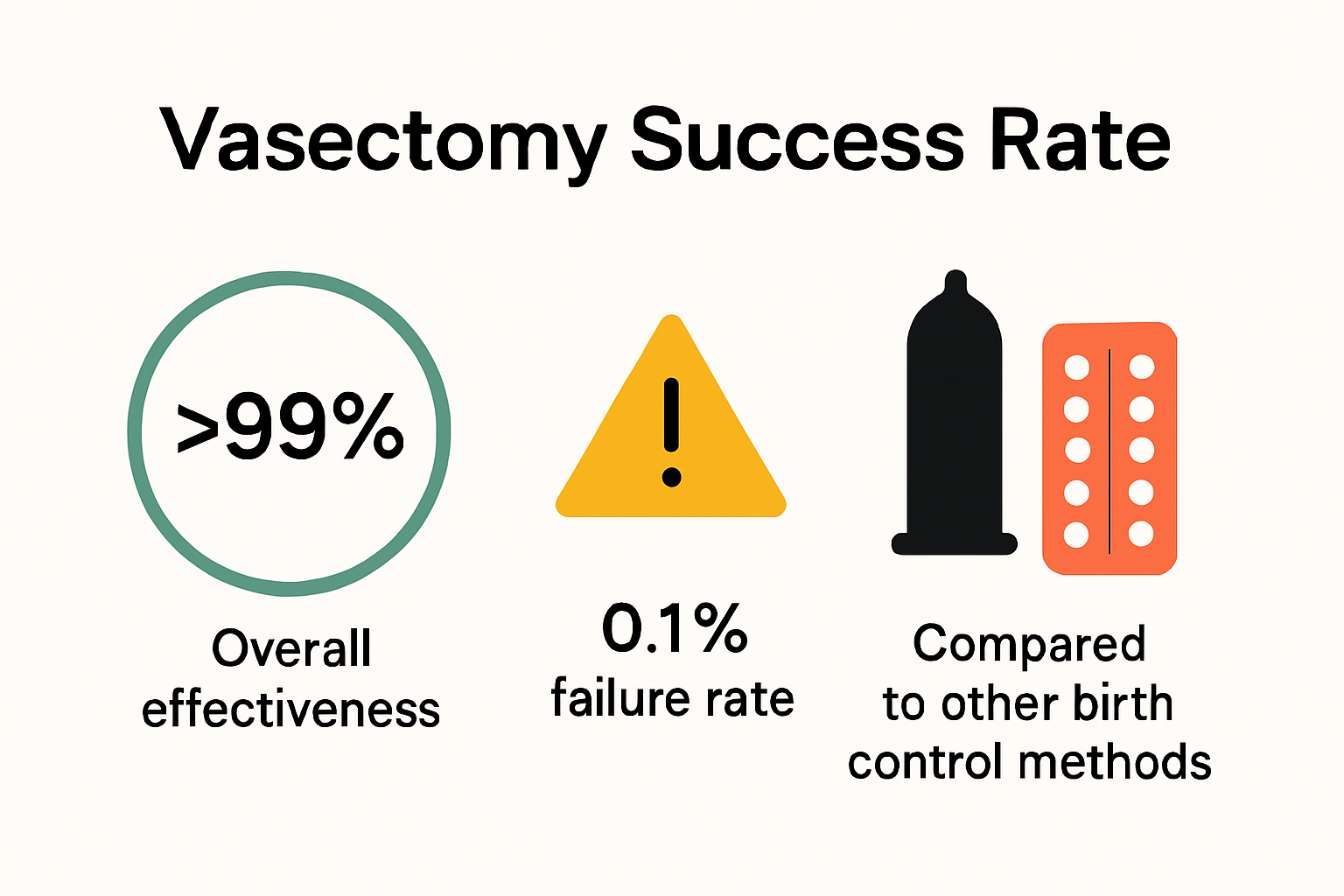Vasectomy is gaining popularity for long term birth control, and for good reason. Medical studies show the vasectomy success rate stands at an incredible 99.95 percent, with only about 1 in 2,000 men experiencing a failure. Surprised? What most people do not realize is that a single negative semen test right after surgery is not a guarantee. The real secret is in the follow-up and ongoing testing, because even the most careful procedures demand repeated checks to make sure sterility truly lasts.
Table of Contents
- Understanding Vasectomy Success Rates And Statistics
- Factors That Affect Vasectomy Effectiveness
- How To Confirm Vasectomy Success After Surgery
- What Vasectomy Failure Means For Couples
Quick Summary
| Takeaway | Explanation |
|---|---|
| Extremely Low Failure Rate | Vasectomies have a success rate of 99.95%, with failures primarily due to rare scenarios such as recanalization or surgical errors. |
| Importance of Post-Procedure Testing | Men should complete semen analyses at least 8-12 weeks post-surgery to confirm sterility; multiple tests may be needed for assurance. |
| Surgeon Expertise Matters | Selecting an experienced, board-certified urologist is crucial, as surgical skill significantly impacts the effectiveness of the procedure. |
| Ongoing Monitoring Recommended | Regular semen analyses and consultations with healthcare providers are advised to ensure continued sterility and address any potential issues. |
| Emotional Considerations for Couples | Vasectomy failure can lead to unexpected emotional challenges; couples should engage in open communication and joint decision-making if issues arise. |
Understanding Vasectomy Success Rates and Statistics
Vasectomy represents one of the most reliable forms of permanent male contraception, with impressively low failure rates that make it an attractive option for men seeking long term birth control. Understanding the precise success rates and underlying statistics helps men make informed decisions about this procedure.

The Science Behind Vasectomy Success
A successful vasectomy fundamentally means blocking sperm from entering the semen during ejaculation. Research from the Cleveland Clinic demonstrates that after the initial 3-6 month healing period, the vasectomy failure rate drops below 1%, which is lower than any other contraceptive method. This near-zero failure rate stems from a precise surgical procedure that completely severs and seals the vas deferens, preventing sperm transportation.
The success timeline is critical. Immediately after the procedure, sperm can still exist in the reproductive tract. This means men must use alternative contraception and undergo post-vasectomy semen analysis to confirm sterility. Our guide on confirming vasectomy success provides detailed insights into this verification process.
Statistical Breakdown of Vasectomy Effectiveness
Comprehensive medical studies reveal compelling statistics about vasectomy success. Urological research indicates that approximately 1 in 2,000 vasectomies ultimately fail, which translates to an extraordinary 99.95% effectiveness rate. These failures can occur through rare scenarios such as:
- Recanalization: Spontaneous reconnection of severed vas deferens
- Surgical Error: Incomplete cutting or sealing of the vas deferens
- Individual Biological Variations: Uncommon physiological responses
Factors influencing success include surgeon expertise, patient healing capabilities, and strict adherence to post-procedure instructions. Medical professionals recommend waiting at least three months or completing 20-30 ejaculations before confirming sterility through comprehensive semen analysis.
Post-procedure testing remains the gold standard for verifying vasectomy success. Men should complete multiple semen analyses to ensure no sperm remain in the ejaculate. Modern at-home testing services like Jack At Home simplify this verification process, offering convenient and accurate methods for men to confirm their vasectomy’s effectiveness without multiple clinic visits.
Men considering vasectomy should approach the procedure with realistic expectations. While statistically extremely reliable, no medical procedure guarantees absolute certainty. Thorough consultation with a urologist, understanding personal medical history, and commitment to follow-up testing are essential steps in achieving optimal outcomes.
Factors That Affect Vasectomy Effectiveness
While vasectomy is widely recognized as one of the most reliable forms of permanent male contraception, several critical factors can influence its overall effectiveness. Understanding these variables helps men make informed decisions and maximize the procedure’s success rate.
Surgical Technique and Surgeon Expertise
The precision of the vasectomy procedure directly impacts its long-term success. Research from a comprehensive UK study revealed that early vasectomy failure rates remain extremely low at 0.6%, highlighting the importance of surgical skill. Experienced urologists who meticulously sever and seal the vas deferens minimize the risk of potential complications.
Key considerations in surgical technique include:
- Complete transection of the vas deferens
- Proper sealing of surgical sites
- Minimal tissue manipulation
- Precise surgical approach
Surgeon selection becomes paramount. Board-certified urologists with extensive experience in microsurgical techniques significantly reduce the probability of procedural errors that could compromise vasectomy effectiveness.
Post-Procedure Compliance and Follow-Up
Success extends beyond the operating room. Our comprehensive guide on post-vasectomy sperm clearance emphasizes the critical nature of patient compliance. Men must understand that immediate sterility is not guaranteed. The reproductive system requires time to clear existing sperm, typically 20-30 ejaculations or approximately three months.
Critical post-procedure steps include:
- Continued use of alternative contraception
- Completing multiple semen analyses
- Strict adherence to medical recommendations
- Patience during the sperm clearance period
Individual Biological Variations
Research from Intercare Hospital highlights that individual biological factors can occasionally impact vasectomy effectiveness. Rare physiological responses such as spontaneous recanalization represent uncommon but potential challenges.
Unique biological factors that might influence vasectomy success include:
- Genetic predisposition to healing
- Individual immune system responses
- Anatomical variations in reproductive structures
- Personal healing capabilities
Men should engage in thorough pre-procedure consultations, discussing personal medical history and potential individual risk factors. While these variations rarely compromise vasectomy effectiveness, understanding potential nuances helps set realistic expectations.
Modern medical advancements and rigorous follow-up protocols have dramatically improved vasectomy reliability. By selecting a skilled surgeon, maintaining strict post-procedure compliance, and understanding individual biological factors, men can maximize their chances of a successful, permanent contraceptive solution.
How to Confirm Vasectomy Success After Surgery
Confirming vasectomy success is a critical step that ensures the effectiveness of the procedure and provides peace of mind for men seeking permanent contraception. The verification process involves multiple stages and precise medical testing to guarantee complete sterility.
The Post-Vasectomy Semen Analysis Timeline
Our comprehensive guide to confirming vasectomy success emphasizes the importance of timing in post-procedure testing. Immediately after a vasectomy, sperm can still exist in the reproductive tract. Medical professionals recommend waiting at least three months or completing 20-30 ejaculations before initial testing.
The recommended testing protocol typically involves:
- First semen analysis at 8-12 weeks post-procedure
- Multiple follow-up analyses to confirm consistent sterility
- Continued use of alternative contraception during the initial waiting period
Patients should understand that a single negative test does not guarantee permanent sterility. Comprehensive testing helps identify the rare instances of spontaneous recanalization or microscopic reconnection.
Methods of Confirming Vasectomy Success
According to the American Medical Association, even after a negative semen test, there remains a very small risk of future pregnancy. This underscores the importance of thorough and repeated testing.
Men have two primary methods for confirming vasectomy success:
- Clinical laboratory testing at a medical facility
- At-home semen analysis kits
At-home testing offers several advantages:
- Convenience: Collect sample in private
- Discretion: Avoid multiple clinic visits
- Accuracy: CLIA-certified laboratory analysis
- Comprehensive reporting: Detailed sperm count and motility information
Long-Term Monitoring and Considerations
Vasectomy confirmation is not a one-time event. Urological experts recommend periodic checks to ensure continued sterility. While extremely rare, spontaneous reconnection can occur years after the initial procedure.
Key long-term monitoring strategies include:
- Annual or biannual semen analyses
- Maintaining awareness of any changes in reproductive health
- Consulting with a urologist about long-term follow-up
Men should approach vasectomy success confirmation as an ongoing process. Modern medical technologies, including advanced at-home testing services, have made this verification more accessible and convenient than ever before.
Ultimately, the goal is to provide men with complete confidence in their contraceptive choice. By following recommended testing protocols, utilizing accurate testing methods, and maintaining open communication with healthcare providers, men can achieve and confirm the highest level of reproductive certainty.
What Vasectomy Failure Means for Couples
Vasectomy failure represents a rare but significant scenario that can profoundly impact couples’ reproductive planning and emotional well-being. Understanding the potential implications, risks, and subsequent steps becomes crucial for men and their partners navigating this unexpected circumstance.
Understanding Rare Vasectomy Failure Scenarios
Research from the Cleveland Clinic reveals a critical insight into vasectomy failures. During the first three to six months post-procedure, the chance of sperm remaining in semen ranges from 0.3% to 9%. After this initial period, the failure rate dramatically drops below 1%, making vasectomy one of the most reliable contraceptive methods available.
Our comprehensive guide on interpreting vasectomy test results emphasizes the importance of understanding potential failure mechanisms. These rare occurrences can stem from several intricate biological processes:
- Spontaneous Recanalization: Unexpected reconnection of severed vas deferens
- Surgical Technique Variations: Incomplete vas deferens interruption
- Individual Physiological Responses: Unique healing mechanisms
Emotional and Practical Implications for Couples
According to the American Medical Association, even after a negative semen test, microscopic channels can potentially develop, allowing sperm to pass through. This minute possibility underscores the emotional complexity couples might face when confronting vasectomy failure.
Potential emotional challenges include:
- Unexpected pregnancy anxiety
- Potential strain on relationship dynamics
- Reconsideration of family planning strategies
- Potential financial and logistical complications
Recommended Steps Following Vasectomy Failure Detection
If a vasectomy failure is detected, couples should approach the situation methodically and collaboratively. Critical steps include:
- Immediate consultation with the original urologist
- Comprehensive semen analysis to confirm sperm presence
- Discussion of potential corrective surgical interventions
- Exploring alternative contraception methods
- Joint counseling to navigate emotional challenges
Couples should recognize that while vasectomy failure is statistically improbable, it’s not entirely impossible. Open communication, regular medical follow-ups, and a proactive approach to reproductive health can mitigate potential risks and uncertainties.
Modern medical advancements and rigorous testing protocols have significantly minimized vasectomy failure risks. By maintaining realistic expectations, staying informed, and working closely with healthcare professionals, couples can confidently navigate their reproductive journey with minimal anxiety and maximum preparedness.
Frequently Asked Questions
What is the success rate of a vasectomy in 2025?
The success rate of a vasectomy is an impressive 99.95%, meaning only about 1 in 2,000 procedures may fail.
How can I confirm if my vasectomy was successful?
To confirm the success of a vasectomy, men should undergo semen analysis at least 8-12 weeks post-surgery, with multiple tests recommended to ensure ongoing sterility.
What factors can influence the effectiveness of a vasectomy?
The effectiveness of a vasectomy can be influenced by the surgical technique used, the surgeon’s expertise, patient compliance with post-procedure instructions, and individual biological variations.
What should I do if I experience a vasectomy failure?
If a vasectomy failure is suspected, consult with your urologist immediately for further semen analysis and discuss potential corrective measures or alternative contraception methods.





